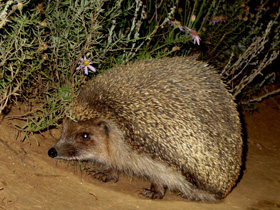The Daurian hedgehog (Mesechinus dauuricus)
Appearance
The Daurian hedgehog (Mesechinus dauuricus) is a species of erinaceomorph mammal in the family Erinaceidae. It is a small solitary hedgehog.
This hedgehog is small, with short needles, varying in colour from light sandy to dark brown; the colour of the thick fur on the abdomen is grey to dark brown. The top of the head is straw-white. The animal is not large, with a body length of 19.5-29 cm and a tail of 25-37 mm, and a weight of 600-1400 g, depending on the season. The head is cone-shaped and the muzzle is moderately elongated. The ears are small, 29-34 mm. The head does not have a strip of bare skin, unlike common hedgehogs. It is less spiny than the common hedgehog because its needles point backwards. The surface of the needles is covered with longitudinal grooves.
Habitat
Its range includes the steppe, forest-steppe and partly southern taiga of Transbaikalia and southeastern Transbaikalia and adjacent areas of northeastern Mongolia and northern China. Occurs sporadically further north, penetrating river valleys. It occurs in the Ingoda, Chita and Shilka river valleys; in the west, it reaches the upper reaches of the Dzhida River. In the east, the area of distribution is limited by the mountain forests of the Borshchovochny and Nerchinskii ranges; the easternmost occurrences are near the settlement of Nerchinskii Zavod and the village of Argun. Argunskoe. Apparently, Mesechinus dauuricus is gradually dispersing northwards along transport routes and across cultivated landscapes.
The most widespread habitats of Mesechinus dauuricus are all types of steppes, pine forests, spruce forests, agrocenoses, surroundings and outskirts of settlements. In the southern taiga zone, the hedgehog inhabits steppe patches and dry pine, larch, birch and mixed forests. It avoids steppe areas with dense, dense grass. It likes areas with a combination of good shelter and foraging conditions, such as slopes with thickets of elm, almond and dogwood trees, and steep ravines.
Lifestyle and nutrition
Hedgehogs are solitary, sedentary and crepuscular. The size of a foraging area varies from 90 to 420 ha, depending on the sex and age of the hedgehog (which is notably larger than the size of individual areas of common hedgehogs). Mesechinus dauuricus has no permanent shelters; males establish dens on the ground, females in shelters. Mesechinus dauuricus is active during the day in cloudy weather.
Diet is dominated by beetles (beetles, lamellar beetles, black flies); spiders are often found. Mesechinus dauuricus also feeds on small mammals (hamsters, pikes), eggs and chicks, snakes (Polozoan), frogs, Mongolian toads, berries (rose hips, dogwood) and carrion.
Mesechinus dauuricus hibernation
Hibernating hedgehogs put on a lot of weight towards the end of autumn. Males hibernate during the second or third decade of August, females and yearlings in mid-September and young hedgehogs in late September or early October. Hibernation lasts between 200 and 245 days. During hibernation, hedgehogs lose more than 30% of their weight. Mass hibernation occurs at the end of April.
Reproduction
Oestrus of Mesechinus dauuricus begins 10-15 days after awakening, usually in mid-May. Before giving birth, the female digs a burrow or cleans and enlarges burrows for moles, pikes and voles. Breeding burrows are 50-120 cm long, 11-19 cm wide and 7-12 cm high; the brood chamber is 13-30 cm deep. At the end of June, after 37-40 days of gestation, the young appear (1-8). The young hedgehogs grow rapidly and in early August the young separate and become independent. Males reach sexual maturity at 10-11 months, but due to competition with older males, they usually do not start breeding until 22 months of age. Longevity is 4-6 years, in captivity up to 7-8 years.
Threats to existence
Among anthropogenic constraints to Mesechinus dauuricus, the most important are: forest and steppe fires, pesticide application, harvesting of agricultural crops and loose housing of dogs. Less significant are: hedgehog deaths on roads and under the hooves of livestock, trapping and keeping in captivity. However, at present the number of predators is decisive for the population: wolf, fox, corsac, steppe polecat, eagle owl, moss-footed murrelet and steppe eagle. The main food competitors of Mesechinus dauuricus are the badger and the raccoon dog.











































